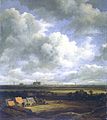
Jacob Isaackszoon van Ruisdael was a Dutch painter, draughtsman, and etcher. He is generally considered the pre-eminent landscape painter of the Dutch Golden Age, a period of great wealth and cultural achievement when Dutch painting became highly popular.

View of Haarlem with Bleaching Fields is an oil on canvas painting by Dutch landscape painter Jacob van Ruisdael. It is an example of Dutch Golden Age painting and Haarlempjes, a specific style of Dutch landscape painting that focuses on views of Haarlem.View of Haarlem with Bleaching Fields is now in the collection of the Kunsthaus Zürich. This painting demonstrates several critical characteristics of 17th-century Dutch landscape painting, including a low horizon line, expressions of Dutch pride of place, and disguised religious symbolism. Through this work, Ruisdael expresses his pride as not only a Dutch citizen but also a citizen of Haarlem. Painted shortly after the end of the Eighty Years' War and the independence of the Dutch Republic, View of Haarlem with Bleaching Fields, and many other Dutch Golden Age paintings, united the newly formed nation under depictions of pride in their land and the prosperity of their country. Ruisdael went on to paint many similar views of Haarlem and its bleaching fields. Even after his death, these views would continue to be painted by his followers and inspire future generations of landscape painters.
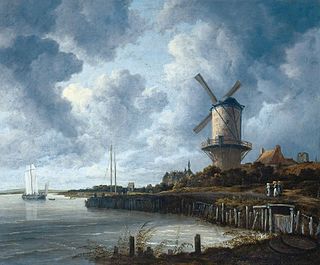
The Windmill of Wijk bij Duurstede is an oil-on-canvas painting by the Dutch painter Jacob van Ruisdael. It is an example of Dutch Golden Age painting and is now in the collection of the Amsterdam Museum, on loan to the Rijksmuseum.

The Ray of Light, also known as Le Coup de Soleil, is an oil on canvas painting by the Dutch painter Jacob van Ruisdael. It is an example of Dutch Golden Age painting and is now in the collection of the Louvre Museum.

View of Egmond aan Zee is an oil on canvas painting by the Dutch landscape painter Jacob van Ruisdael. It is an example of Dutch Golden Age painting and is now in the collection of the Nationalmuseum in Stockholm.

View of Bentheim Castle is an oil on canvas painting of Burg Bentheim by the Dutch landscape painter Jacob van Ruisdael. It is an example of Dutch Golden Age painting and is now in the collection of the Rijksmuseum.

Two Watermills and an Open Sluice near Singraven is an oil on canvas painting by the Dutch landscape painter Jacob van Ruisdael. It is an example of Dutch Golden Age painting and is now in the collection of the National Gallery.

Landscape with Waterfall is an oil on canvas painting by the Dutch landscape painter Jacob van Ruisdael. It is an example of Dutch Golden Age painting and is now in the collection of the Amsterdam Museum, on loan to the Rijksmuseum.
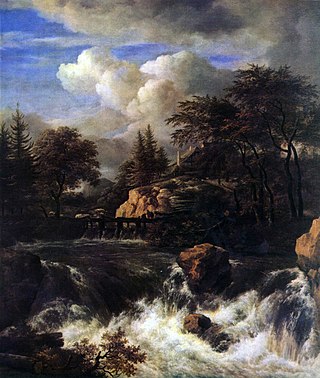
A Waterfall in a Rocky Landscape is an oil painting on canvas by the Dutch landscape painter Jacob van Ruisdael. It is an example of Dutch Golden Age painting and is now in the collection of the National Gallery.

A Landscape with a Ruined Castle and a Church is an oil on canvas painting by the Dutch landscape painter Jacob van Ruisdael. It is an example of Dutch Golden Age painting and is now in the collection of the National Gallery.

A Wooded Marsh is an oil on canvas painting by the Dutch landscape painter Jacob van Ruisdael. It is an example of Dutch Golden Age painting and is now in the collection of the Hermitage Museum in St. Petersburg, Russia.
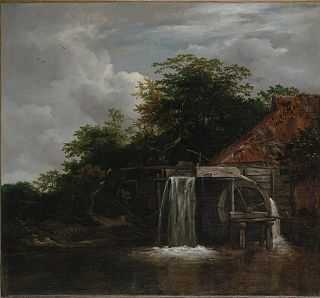
The Watermill is an oil on canvas painting by the Dutch landscape painter Jacob van Ruisdael. It is an example of Dutch Golden Age painting and is now in the collection of the National Gallery of Victoria.
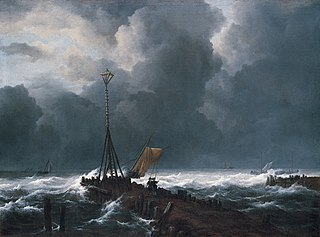
Rough Sea at a Jetty is an oil on canvas painting by the Dutch landscape painter Jacob van Ruisdael. It is an example of Dutch Golden Age painting and is now in the collection of the Kimbell Art Museum.
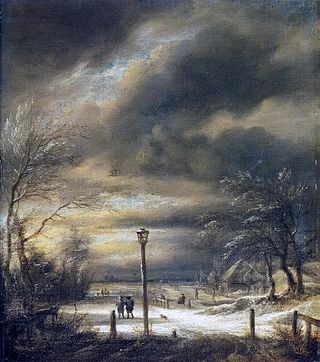
Winter Landscape near Haarlem is an oil on canvas painting by the Dutch landscape painter Jacob van Ruisdael. It is an example of Dutch Golden Age painting and is now in the collection of the Städel. This painting was documented by Hofstede de Groot in 1911, who wrote; "992. A WINTER LANDSCAPE. A snow-bound plain with trees to right and left. In the centre a road leads to the distance; away to the right is a cottage. In the centre foreground stands a solitary lamp-post. To the left of this are two travellers with a dog. Signed in full, according to the Sedelmeyer sale-catalogue, but the Frankfort catalogue does not mention a signature; canvas, 14 1/2 inches by 12 1/2 inches. Exhibited at Vienna, 1873, No. 165.
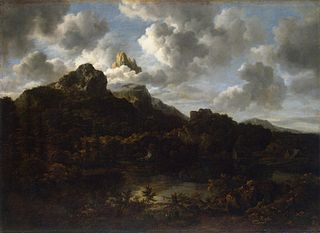
Mountainous Landscape is an oil on canvas painting by the Dutch landscape painter Jacob van Ruisdael. It is an example of Dutch Golden Age painting and is now in the collection of the Hermitage, in Saint Petersburg.
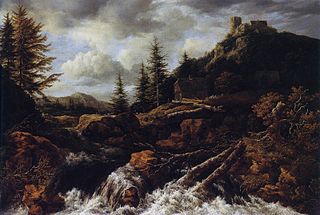
Waterfall in a Mountainous Landscape with a Ruined Castle is an oil on canvas painting by the Dutch landscape painter Jacob van Ruisdael. It is an example of Dutch Golden Age painting and is now in the collection of the Mount Stuart House.

Dune Landscape near Haarlem, also known as The Bush and The Thicket near Haarlem, is an oil on canvas painting by the Dutch Golden Age painter Jacob van Ruisdael. It is in the collection of the Louvre in Paris.

Panoramic view of the Amstel looking toward Amsterdam is a 17th-century oil on canvas painting by the Dutch Golden Age painter Jacob van Ruisdael. It is in the collection of the Fitzwilliam Museum in Cambridge.

View of the Dam and Damrak at Amsterdam is a 17th-century oil on canvas painting by the Dutch Golden Age painter Jacob van Ruisdael. It is in the collection of the Mauritshuis in the Hague. It gives a bird's eye view of the crowd watching the parade of the civic guard on the Dam Square, the main square of Amsterdam.

Landscape with a Windmill Near a Town Moat is an oil on canvas painting by the Dutch landscape painter Jacob van Ruisdael. It is an example of Dutch Golden Age painting and is now in a private collection.

